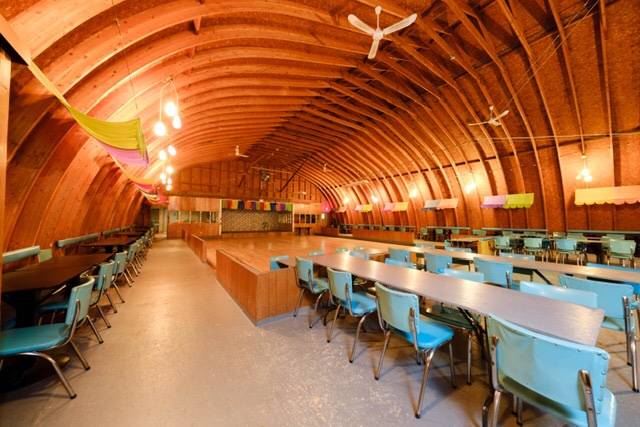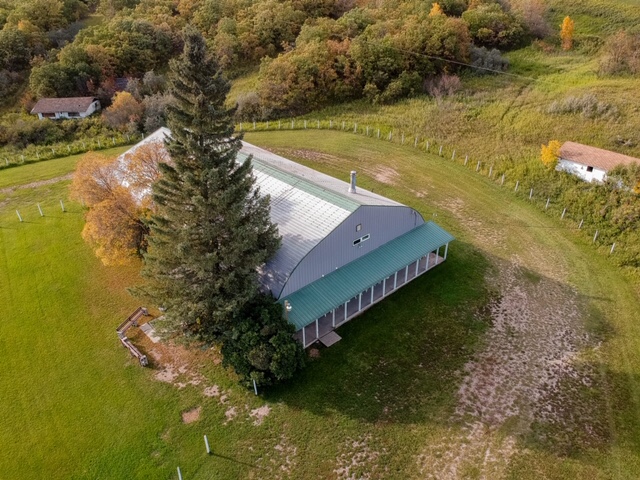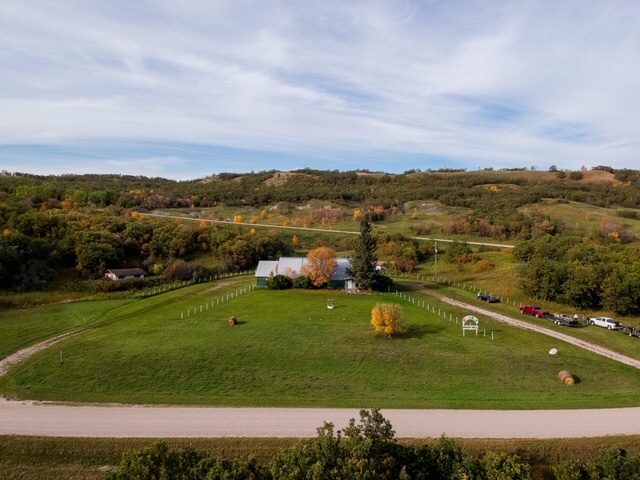Rainbow Hall is closing its doors after thirty-three years in operation. It has been the home of the Rainbow Social Dance Club, weddings, anniversaries, family reunions and a meeting venue for different organizations.

Built in 1965 by Roy & Margaret Munch, the former Club 65 was sold in 1985 to Lena and Ernie Tocker who then renamed it Rainbow Hall.
The building is located seven miles south of Esterhazy along the scenic route.
Terry Tocker, daughter of Lena and Ernie, said, “We’ve seen people meet here, fall in love and get married.”
Closing the doors was not an easy decision.
She said, “The first time I came down here [this year], it was a very emotional experience. I walked in here with my husband; it was like I could see people dancing and hear music bouncing off the walls. The next time I come to cut grass I’ll be expecting to see someone trailer coming up the road to park for the next dance. It’s sad.”
She mentioned she has mixed emotions about closing, but she missed many events due to the demand of the Rainbow Hall. The idea of closing has been afloat for a few years and was often put off, but the funds are not there to fund the requirements for the dances.
Terry said, “The younger generation has other interests and, unfortunately, they’re missing out on a lot of fun. Dancing is an opportunity to socialize, but also exercise in an innocent way.”
Terry mentioned how the people who regularly attended these dances treat each other like family. She said, “I’ll never forget, when my dad passed away, a quarter of the people at the funeral were people that came here. We’ve seen people grow from [young] kids that learned to dance here who grew into adults and come back here.”
She continued, “We see people come here as adults who don’t know how to dance. When you come here if you’re a male, you won’t be sitting as there were usually two women to each man.” She joked, “They would detect very quickly that you don’t know how to dance and look out.” Speaking about the attendees, she said, “A lot of people thought this was a singles club, as we had many single people come to dance, but we had a mixture of married couples too. They were all people who liked to dance.”

Some believed the previously named Club 65 was for attendees over the age of sixty-five, such is why the name was changed to Rainbow Hall in 1985. During its thirty-three years the hall brought guests of all ages and backgrounds together.
Speaking about how the dance hall was unique, she said, “I had gone to many dances where if you came with two couples, that is all you talked to and all you danced with. The thing many people have said about this place is that everyone is so friendly. When that first song plays you would see someone who is single going over there to dance with someone who is married, newly widowed, etc. Everybody danced with each other and it was like one big happy family.”
The Rainbow Hall rests on a twenty-three acre property which was more than enough to hold the campers of the many attendees who stayed the weekend.
When Terry’s dad passed away, she had to make a difficult decision with her mother regarding the future of the hall. Terry said, “We need to decide what we’re going to do. Do we shut down because it’s just you and I, or do we carry on for dad?”
Terry’s parents had a huge love of dancing which was passed down to her, surely fueling the passion she felt toward the dance hall over the decades.
“I grew up in it.” She said, “I think I missed three dances in thirty-three years…When we first started having dances here, our crowds were around fifteen at a time because no one knew we were open.”
Prior to the Tocker family purchasing the hall from the Munch family, it was closed for two years. Mr. and Mrs. Munch had a social club with a once a month dance. They also held many weddings and catered numerous events. Once the Tocker family purchased it, they realized many of their guests were coming back for their 25th and 50th anniversary dances. The hall was a place where they were married, had their dance and made some of the most special memories of their lives.
When you walk into the hall, the original hardwood floor immediately meets your eyes. Many cannot understand how such a precious flooring could be used in such an energetic atmosphere, but Terry mentioned the guests were always very diligent to not take their drinks on it.
The attendance numbers rose over the first five years until the amount of dance go-ers neared a couple hundred in a single night.
Over the years, the numbers dropped to ninety, to eighty, then down to around forty attendees.
Terry said, “If we had eighty people here, ten would have drank. There would always be a designated driver.”
Some years there would be twenty-five dances, then it went down to fifteen. It was very difficult to keep the hall heated in early spring and late fall. The season ran from the third Saturday in May until mid-September. The organization tried to work together with other towns to not overlap weekends. Bands would have to be booked a year in advance. As bands dismantled or did not want to travel as far as Esterhazy, it became more difficult to find a variety of affordable entertainment.
Over twenty different bands played in the hall throughout the years. Len Gadica, the one-man band who used to be with the Rising Sons brought some of the largest crowds.
The crowd is typically fifty and above. Younger couples would also come out with their families on long weekends, or if they were about to get married they would attend to learn how to dance before their big wedding day.
The establishment’s liquor license allowed parents to bring their kids. This exposed the next generation to dances like the butterfly, the bird dance, “bingo or snowball” dances, waltz, chatice as well as rock and polka.
Theme nights were a highlight to many as the hall would be decorated for events like Christmas in July, Pyjama Night (the first dance of each year), Western night, Hawaiian night, Mexican night and the Halloween masquerade.
Every three weeks there was a theme night.
Tocker said, “People loved it when we had theme nights. One gentleman named Albert showed up in a binder twine ‘grass’ skirt for a Hawaiian theme dance.”
Upstairs there is a loft that overlooks the dance hall. After bands finished their set for the night, they could stay in the loft and wake up to a breakfast prepared by Terry and her mom.
The Rainbow Hall hosted an annual polka-fest. For eleven years, the event brought in two bands who would play from 5 P.M. until after midnight. When one band needed a break, the second was up and playing within two minutes to keep the good times rolling. It was nonstop music and people danced the entire time.

Terry said the Rainbow Hall has seen people attend from many countries. Visitors from across Canada, New Zealand, Japan, England, Denmark, U.S.A., Mexico, and Venezuela have danced the night away under ‘the Rainbow.’
Those from big cities came out and said they couldn’t believe a place like Rainbow Hall still existed.
Many from Esterhazy did not make it out as the majority of the guests attending came from further out. “I’d have campers all over the place. The States, Ontario, Nova Scotia. Bigger cities like Winnipeg who would drive down and stay in town at a hotel. The local people didn’t support it.”
There would always be a crowd from Churchbridge, Yorkton, Canora, Langenburg, St. Lazare, Bredenbury, and Saltcoats, as well as a handful from a few minutes down the road in Esterhazy.
Terry was the groundskeeper, worked the kitchen with her mom, stocked supplies, sold tickets, and performed maintenance duties with her husband.
“I was always at the door with my mom. We saw people come in and could see them how a couple’s relationship blossomed from one Saturday to the next. One night it started with a couple of dances and the next weekend you could notice a relationship developing. It would make me tingle inside knowing that ‘if they hadn’t met here, would they have met?’ then seven months down the road the couple announces they are getting engaged. It all started at the Rainbow Hall.”
Terry would be outside cutting grass sometimes and people would stop by who were driving across Canada in their camper. They would stop by going through a scenic drive in the valley, wondering what it was all about; they would end up staying for the weekend and taking in the dance.
She reflected, “There was so much I loved about it. From cutting the grass, knowing that all the fruits of my labour would be enjoyed when I opened the door at seven o’clock. Many people who came through the door would say how they’ve looked forward to the event all week. Seeing the smile on their face, seeing them come through the door, coming here to enjoy [themselves], leaving their troubles behind and having fun. Most of the people who came here didn’t drink. They were on a high, but the high was being at Rainbow Hall.”
She said she “did it for the love of dance and to know it brought so much joy to the people who walked through the door. It wasn’t about making money.”
Liquor and food sales did not cover the lost revenue from admission sales. As bills continued to rise, while sales did not, the difficult decision was made to close the doors. Although the hall was not in operation to make money, a business owner cannot be expected to lose money and go into their personal savings on a regular basis to keep the facility open.

Terry made a point of making everyone feel at home. If someone came there who did not know anyone else, she found a group for them to begin socializing with for the night. Everyone felt welcomed. Those who were shy could start by helping in the bar before finding themselves being pulled onto the dance floor soon after. “They got [to the hall] and I took over after that”
Her niece, Marylyn, mentions how she will miss the hall after meeting so many people there and learning how to dance. People would take her left and right to learn to dance and Terry mentioned how you could see her blossom more each year. Marylyn always looked forward to Saturday nights.
The Rainbow Hall is still available to rent for those interested. It is a very rustic building which interests many groups. Call (306) 745-7144 for more information.
Terry mentioned, “Many memories and many friends have been made over the years. Mom, Alan, Marilyn and myself will miss seeing our ‘Rainbow Family’ every Saturday night. Take care and God bless.”
Photos submitted courtesy of Matt Johnson of Matte Black Photography and Nancy Johnson Re/Max Bridge City Realty.